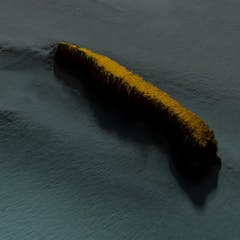
Articles sur Shipwrecks
Affichage de 1 à 20 de 35 articles

Shipwrecks and their cargo can be sites of conflict – but also opportunity.

The SS Hartdale was sunk by a German U-boat in 1915 and its final resting place had long been unknown.

The boat was sunk while still laden with treasure including 11 million gold and silver coins, emeralds and other precious cargo.

Artificial reefs are structures that humans put in place underwater that create habitat for sea life. A new study shows for the first time how much of the US ocean floor they cover.

When ships sink, they add artificial structures to the seafloor that can quickly become diverse, ecologically important underwater communities.

David Grann’s latest book recounts an 18th century shipwreck and the life and death struggles of its survivors.

The recent tragedy of the Titan submersible bore striking parallels to one of the most widely read novels about life at sea.

What makes billionaires risk their lives to see the Titanic wreck?

The St. Lawrence is one of the most difficult rivers in the world to navigate. It has been the site of collisions, groundings and shipwrecks. Several thousand wrecks lie beneath its surface.

Earlier this month, one of the most famous shipwrecks in history was discovered in a part of Antarctica claimed by multiple nations.

We’re searching for ways to use recovered bones and teeth to better understand time spent in the sea, and the overall journey of the mortal remains.

Throughout the past 230 years, over 1,200 vessels met their end on the reef – but only 114 have been found.

Shipwrecks, plane crashes and lost desert expeditions in Australian history all feature stories of horror and disaster that rival the thrilling TV show Yellowjackets.

Archival records of Dutch timber trade before 1650 are rare or lost. But the wooden timbers of the Batavia contain many secrets.

Money cowries were used for thousands of years as currency across the Indo-Pacific world but introduced into Atlantic commercial networks relatively late.

It’s difficult to tell a shipwreck from a natural feature on the ocean floor in a scan taken from a plane or ship. This project used deep learning to get it right 92% of the time.

Oceanographer Robert D. Ballard, who is best known for finding the wreck of Titanic, has written a memoir recounting his biggest discoveries and calling for more ocean exploration.

A recent ruling allowing a new expedition to the Titanic wreck gives the go ahead to commercial exploitation.

Seeking ways to engage students with Shakespeare’s Scottish play in far north Queensland, highlights disjunctions and surprising correlations between play and place.

The sediments that accumulate beneath seagrass meadows can act as secure vaults for shipwrecks and other precious artefacts, by stopping water and oxygen from damaging the delicate timbers.
